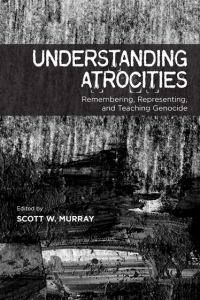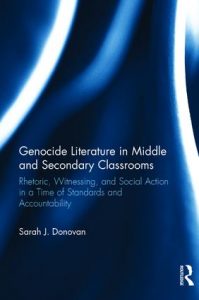 As a middle and high school history and social studies teacher, I have taught about the Holocaust and other genocides for many years. At the beginning of my career, students in my classes would have encountered only the Holocaust, but, recently, I have broadened my curriculum to include many additional examples and aspects of genocide. Despite growing efforts to expand the field of genocide education, there is still a gulf between academic scholarship and curriculum and practice within secondary classrooms. Scholarship, often inaccessible for secondary educators, is slow to make its way into course content. Understanding Atrocities: Remembering, Representing, and Teaching Genocide (2017) is the latest among recent efforts to bridge this gap and recognize the role of educators at all levels and community organizations in conversations about genocide education. This collection expands the conversation to include many voices, especially concerning the teaching of genocides other than, or in addition to, the Holocaust.
As a middle and high school history and social studies teacher, I have taught about the Holocaust and other genocides for many years. At the beginning of my career, students in my classes would have encountered only the Holocaust, but, recently, I have broadened my curriculum to include many additional examples and aspects of genocide. Despite growing efforts to expand the field of genocide education, there is still a gulf between academic scholarship and curriculum and practice within secondary classrooms. Scholarship, often inaccessible for secondary educators, is slow to make its way into course content. Understanding Atrocities: Remembering, Representing, and Teaching Genocide (2017) is the latest among recent efforts to bridge this gap and recognize the role of educators at all levels and community organizations in conversations about genocide education. This collection expands the conversation to include many voices, especially concerning the teaching of genocides other than, or in addition to, the Holocaust.
Genocide Education
 Review of Sarah Donovan’s (2016) Genocide Literature in Middle and Secondary Classrooms: Rhetoric, Witnessing, and Social Action in a Time of Standards and Accountability.
Review of Sarah Donovan’s (2016) Genocide Literature in Middle and Secondary Classrooms: Rhetoric, Witnessing, and Social Action in a Time of Standards and Accountability.
In 2016, Michigan became the newest state to enact legislation to mandate the instruction of genocides for secondary students, specifically citing the Holocaust and Armenian genocide. Michigan joined seven states that have legislative mandates to teach about the Holocaust and genocide in public middle and high schools. Currently, several projects are calling for directives to teach about the Holocaust from all 50 states (e.g. New York’s Anne Frank Center for Mutual Respect and The Butterfly Project). more...
On the 29th of November 2016, State representative Frank Hornstein (DFL) organized a public lecture through the Sabo Center for Democracy and Citizenship at Augsburg College entitled The Use of Holocaust and Nazi Analogies in American Politics. The speaker for the event, Professor Gavriel Rosenfeld (Fairfield University), was interviewed for this month’s scholar spotlight.
Early this week Frank Navarro, a United States Holocaust Memorial Museum trained teacher who has taught at Mountain View High School in California for 40 years, was put on leave after a parent complained about the parallels he was drawing in his world studies class. He was accused of comparing Trump to Hitler, but in actuality he had only pointed out the connections between Trump’s presidential campaign and Hitler’s rise to power.
On September 1 of this year, Holocaust scholar Michael Berenbaum wrote in the article With gratitude toward Donald Trump, how as an educator, he was grateful to Trump for making it easier for him to explain to his students, how it was possible for the Nazis and Hitler to come to power. In my own classroom, it is my students who have made the connections, as I certainly did not have to spell it out for them. We all agree that Trump is not Hitler, but certainly the rhetoric and unabashed racism, antisemitism and xenophobia unleashed by his campaign reminds us of the tactics used by Hitler, the Nazis and his followers.
Last week marked the 154th anniversary of a conflict that would reverberate across the United States. Its history has been clouded by the American Civil War, leaving it often as a mere footnote in larger conflicts. Fighting in the Dakota Conflict unfolded over only six weeks, during which hundreds of Minnesota settlers were killed or displaced. However, it is the conflicts impact on the Dakota that has left the longest legacy. After the war, more than eight hundred Dakota men were sentenced to death and thirty-eight would be hung in Mankato in 1862 – still the largest mass execution in American history. More than 1,600 women, children and the elderly spent a winter interred on Pike Island on the Mississippi before being shipped to reservations in Nebraska. Disease and starvation was rampant. In another act of indignity, Congress passed legislation banning the Dakota from returning to Minnesota – a law that remains on the books more than a century and a half later.
 Review of Sarah Donovan’s (2016) Genocide Literature in Middle and Secondary Classrooms: Rhetoric, Witnessing, and Social Action in a Time of Standards and Accountability.
Review of Sarah Donovan’s (2016) Genocide Literature in Middle and Secondary Classrooms: Rhetoric, Witnessing, and Social Action in a Time of Standards and Accountability.
In 2016, Michigan became the newest state to enact legislation to mandate the instruction of genocides for secondary students, specifically citing the Holocaust and Armenian genocide. Michigan joined seven states that have legislative mandates to teach about the Holocaust and genocide in public middle and high schools. Currently, several projects are calling for directives to teach about the Holocaust from all 50 states (e.g. New York’s Anne Frank Center for Mutual Respect and The Butterfly Project). more...
On the 29th of November 2016, State representative Frank Hornstein (DFL) organized a public lecture through the Sabo Center for Democracy and Citizenship at Augsburg College entitled The Use of Holocaust and Nazi Analogies in American Politics. The speaker for the event, Professor Gavriel Rosenfeld (Fairfield University), was interviewed for this month’s scholar spotlight.
Early this week Frank Navarro, a United States Holocaust Memorial Museum trained teacher who has taught at Mountain View High School in California for 40 years, was put on leave after a parent complained about the parallels he was drawing in his world studies class. He was accused of comparing Trump to Hitler, but in actuality he had only pointed out the connections between Trump’s presidential campaign and Hitler’s rise to power.
On September 1 of this year, Holocaust scholar Michael Berenbaum wrote in the article With gratitude toward Donald Trump, how as an educator, he was grateful to Trump for making it easier for him to explain to his students, how it was possible for the Nazis and Hitler to come to power. In my own classroom, it is my students who have made the connections, as I certainly did not have to spell it out for them. We all agree that Trump is not Hitler, but certainly the rhetoric and unabashed racism, antisemitism and xenophobia unleashed by his campaign reminds us of the tactics used by Hitler, the Nazis and his followers.
Last week marked the 154th anniversary of a conflict that would reverberate across the United States. Its history has been clouded by the American Civil War, leaving it often as a mere footnote in larger conflicts. Fighting in the Dakota Conflict unfolded over only six weeks, during which hundreds of Minnesota settlers were killed or displaced. However, it is the conflicts impact on the Dakota that has left the longest legacy. After the war, more than eight hundred Dakota men were sentenced to death and thirty-eight would be hung in Mankato in 1862 – still the largest mass execution in American history. More than 1,600 women, children and the elderly spent a winter interred on Pike Island on the Mississippi before being shipped to reservations in Nebraska. Disease and starvation was rampant. In another act of indignity, Congress passed legislation banning the Dakota from returning to Minnesota – a law that remains on the books more than a century and a half later.
